Strategic HRM Report: Recruitment, Appraisal, Compensation Analysis
VerifiedAdded on 2019/12/03
|10
|2921
|176
Report
AI Summary
This report provides a comprehensive analysis of the strategic role of Human Resource Management (HRM) in driving organizational performance. It delves into three key areas: recruitment, performance appraisal, and compensation strategies. The report explores the importance of effective recruitment processes, including sourcing the best talent and managing job applications, using examples like Marks and Spencer and Sainsbury. It then examines performance appraisal systems, their objectives, and how they provide feedback, aid in promotion decisions, and encourage performance improvement, again using Marks and Spencer and Sainsbury as examples. Finally, the report discusses compensation strategies, highlighting their role in retaining valuable employees, improving performance, and the use of various compensation tools. The report emphasizes the importance of aligning HRM practices with organizational goals and objectives to achieve success, and provides examples of how different companies implement these strategies.
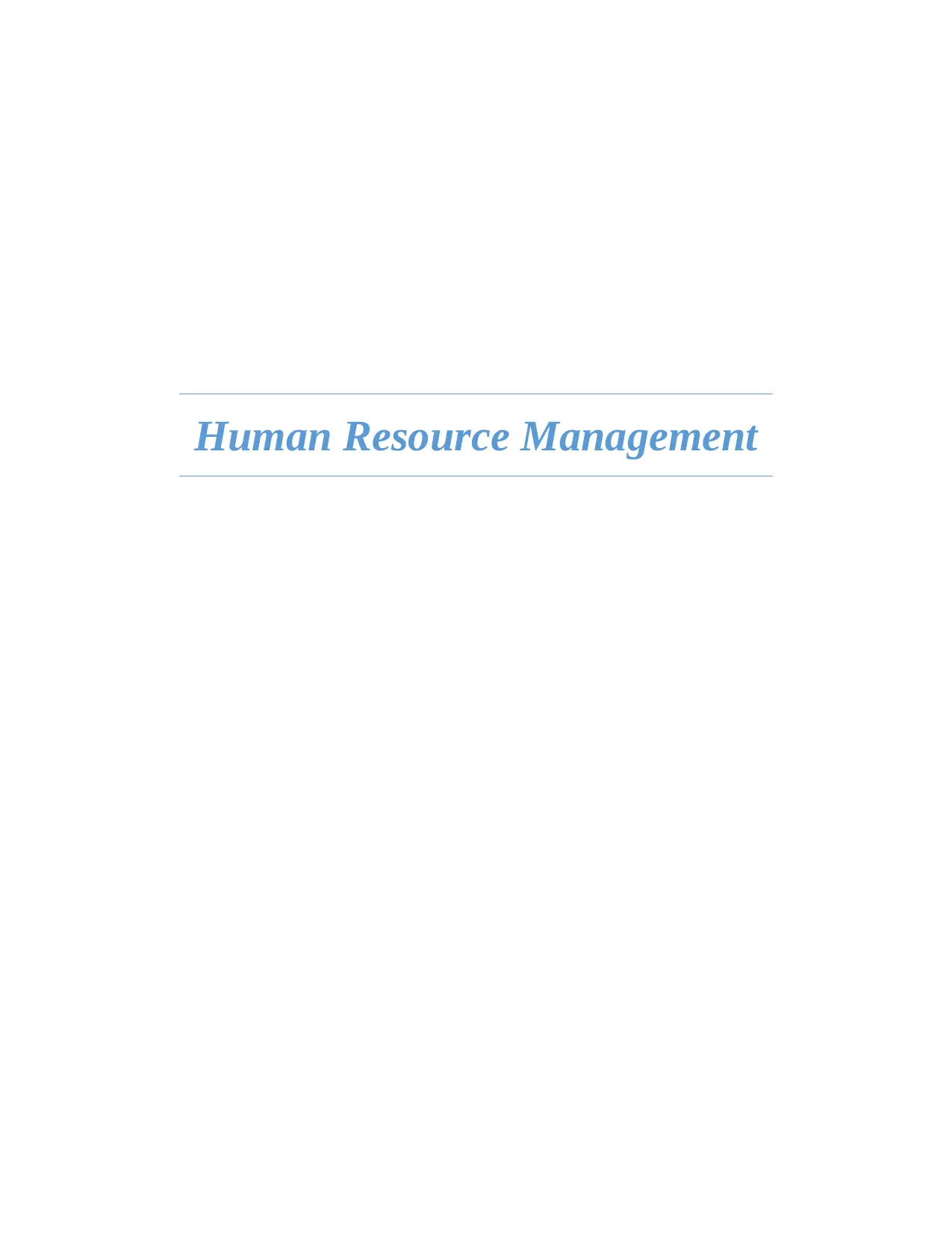
Human Resource Management
Paraphrase This Document
Need a fresh take? Get an instant paraphrase of this document with our AI Paraphraser
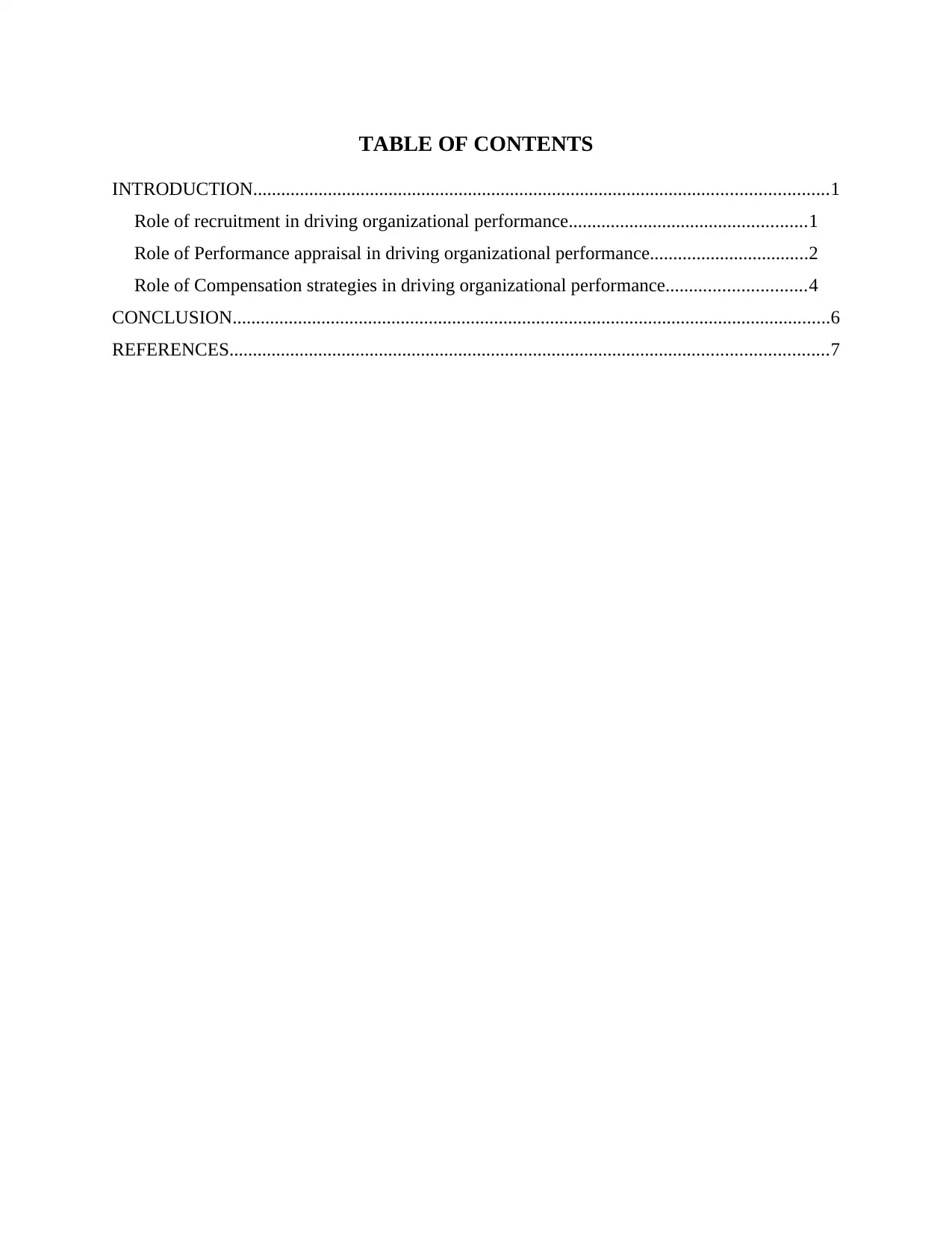
TABLE OF CONTENTS
INTRODUCTION...........................................................................................................................1
Role of recruitment in driving organizational performance...................................................1
Role of Performance appraisal in driving organizational performance..................................2
Role of Compensation strategies in driving organizational performance..............................4
CONCLUSION................................................................................................................................6
REFERENCES................................................................................................................................7
INTRODUCTION...........................................................................................................................1
Role of recruitment in driving organizational performance...................................................1
Role of Performance appraisal in driving organizational performance..................................2
Role of Compensation strategies in driving organizational performance..............................4
CONCLUSION................................................................................................................................6
REFERENCES................................................................................................................................7
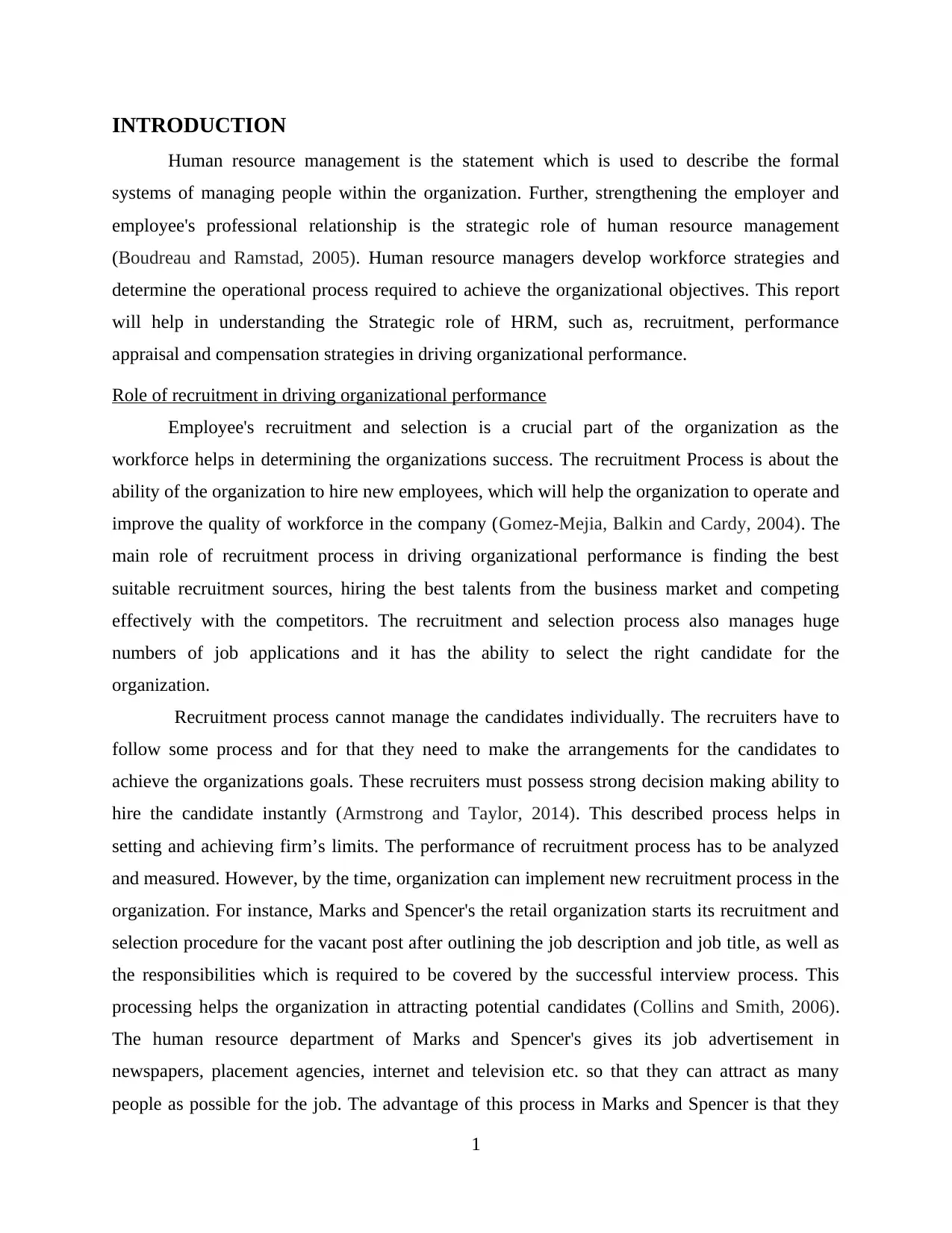
INTRODUCTION
Human resource management is the statement which is used to describe the formal
systems of managing people within the organization. Further, strengthening the employer and
employee's professional relationship is the strategic role of human resource management
(Boudreau and Ramstad, 2005). Human resource managers develop workforce strategies and
determine the operational process required to achieve the organizational objectives. This report
will help in understanding the Strategic role of HRM, such as, recruitment, performance
appraisal and compensation strategies in driving organizational performance.
Role of recruitment in driving organizational performance
Employee's recruitment and selection is a crucial part of the organization as the
workforce helps in determining the organizations success. The recruitment Process is about the
ability of the organization to hire new employees, which will help the organization to operate and
improve the quality of workforce in the company (Gomez-Mejia, Balkin and Cardy, 2004). The
main role of recruitment process in driving organizational performance is finding the best
suitable recruitment sources, hiring the best talents from the business market and competing
effectively with the competitors. The recruitment and selection process also manages huge
numbers of job applications and it has the ability to select the right candidate for the
organization.
Recruitment process cannot manage the candidates individually. The recruiters have to
follow some process and for that they need to make the arrangements for the candidates to
achieve the organizations goals. These recruiters must possess strong decision making ability to
hire the candidate instantly (Armstrong and Taylor, 2014). This described process helps in
setting and achieving firm’s limits. The performance of recruitment process has to be analyzed
and measured. However, by the time, organization can implement new recruitment process in the
organization. For instance, Marks and Spencer's the retail organization starts its recruitment and
selection procedure for the vacant post after outlining the job description and job title, as well as
the responsibilities which is required to be covered by the successful interview process. This
processing helps the organization in attracting potential candidates (Collins and Smith, 2006).
The human resource department of Marks and Spencer's gives its job advertisement in
newspapers, placement agencies, internet and television etc. so that they can attract as many
people as possible for the job. The advantage of this process in Marks and Spencer is that they
1
Human resource management is the statement which is used to describe the formal
systems of managing people within the organization. Further, strengthening the employer and
employee's professional relationship is the strategic role of human resource management
(Boudreau and Ramstad, 2005). Human resource managers develop workforce strategies and
determine the operational process required to achieve the organizational objectives. This report
will help in understanding the Strategic role of HRM, such as, recruitment, performance
appraisal and compensation strategies in driving organizational performance.
Role of recruitment in driving organizational performance
Employee's recruitment and selection is a crucial part of the organization as the
workforce helps in determining the organizations success. The recruitment Process is about the
ability of the organization to hire new employees, which will help the organization to operate and
improve the quality of workforce in the company (Gomez-Mejia, Balkin and Cardy, 2004). The
main role of recruitment process in driving organizational performance is finding the best
suitable recruitment sources, hiring the best talents from the business market and competing
effectively with the competitors. The recruitment and selection process also manages huge
numbers of job applications and it has the ability to select the right candidate for the
organization.
Recruitment process cannot manage the candidates individually. The recruiters have to
follow some process and for that they need to make the arrangements for the candidates to
achieve the organizations goals. These recruiters must possess strong decision making ability to
hire the candidate instantly (Armstrong and Taylor, 2014). This described process helps in
setting and achieving firm’s limits. The performance of recruitment process has to be analyzed
and measured. However, by the time, organization can implement new recruitment process in the
organization. For instance, Marks and Spencer's the retail organization starts its recruitment and
selection procedure for the vacant post after outlining the job description and job title, as well as
the responsibilities which is required to be covered by the successful interview process. This
processing helps the organization in attracting potential candidates (Collins and Smith, 2006).
The human resource department of Marks and Spencer's gives its job advertisement in
newspapers, placement agencies, internet and television etc. so that they can attract as many
people as possible for the job. The advantage of this process in Marks and Spencer is that they
1
⊘ This is a preview!⊘
Do you want full access?
Subscribe today to unlock all pages.

Trusted by 1+ million students worldwide
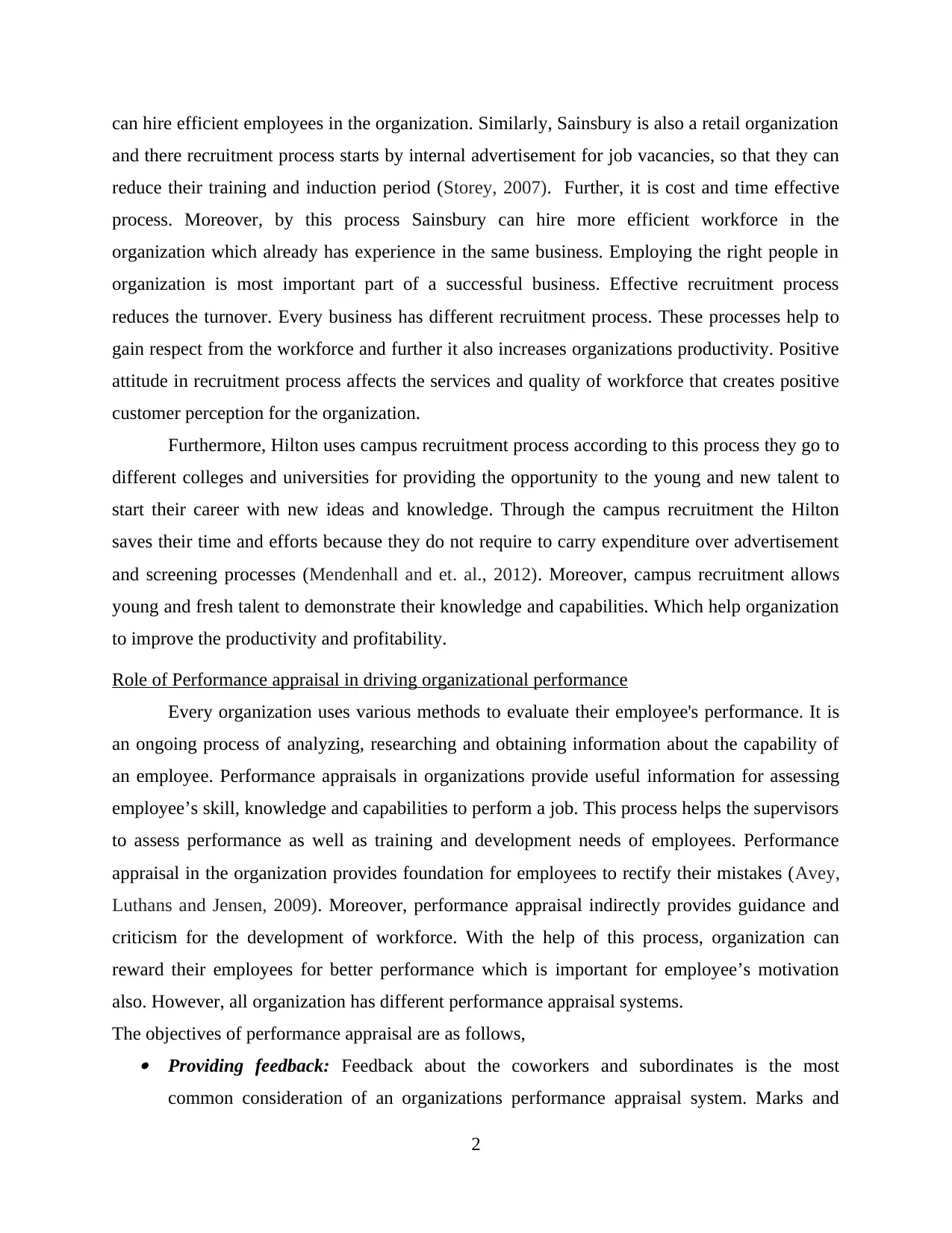
can hire efficient employees in the organization. Similarly, Sainsbury is also a retail organization
and there recruitment process starts by internal advertisement for job vacancies, so that they can
reduce their training and induction period (Storey, 2007). Further, it is cost and time effective
process. Moreover, by this process Sainsbury can hire more efficient workforce in the
organization which already has experience in the same business. Employing the right people in
organization is most important part of a successful business. Effective recruitment process
reduces the turnover. Every business has different recruitment process. These processes help to
gain respect from the workforce and further it also increases organizations productivity. Positive
attitude in recruitment process affects the services and quality of workforce that creates positive
customer perception for the organization.
Furthermore, Hilton uses campus recruitment process according to this process they go to
different colleges and universities for providing the opportunity to the young and new talent to
start their career with new ideas and knowledge. Through the campus recruitment the Hilton
saves their time and efforts because they do not require to carry expenditure over advertisement
and screening processes (Mendenhall and et. al., 2012). Moreover, campus recruitment allows
young and fresh talent to demonstrate their knowledge and capabilities. Which help organization
to improve the productivity and profitability.
Role of Performance appraisal in driving organizational performance
Every organization uses various methods to evaluate their employee's performance. It is
an ongoing process of analyzing, researching and obtaining information about the capability of
an employee. Performance appraisals in organizations provide useful information for assessing
employee’s skill, knowledge and capabilities to perform a job. This process helps the supervisors
to assess performance as well as training and development needs of employees. Performance
appraisal in the organization provides foundation for employees to rectify their mistakes (Avey,
Luthans and Jensen, 2009). Moreover, performance appraisal indirectly provides guidance and
criticism for the development of workforce. With the help of this process, organization can
reward their employees for better performance which is important for employee’s motivation
also. However, all organization has different performance appraisal systems.
The objectives of performance appraisal are as follows, Providing feedback: Feedback about the coworkers and subordinates is the most
common consideration of an organizations performance appraisal system. Marks and
2
and there recruitment process starts by internal advertisement for job vacancies, so that they can
reduce their training and induction period (Storey, 2007). Further, it is cost and time effective
process. Moreover, by this process Sainsbury can hire more efficient workforce in the
organization which already has experience in the same business. Employing the right people in
organization is most important part of a successful business. Effective recruitment process
reduces the turnover. Every business has different recruitment process. These processes help to
gain respect from the workforce and further it also increases organizations productivity. Positive
attitude in recruitment process affects the services and quality of workforce that creates positive
customer perception for the organization.
Furthermore, Hilton uses campus recruitment process according to this process they go to
different colleges and universities for providing the opportunity to the young and new talent to
start their career with new ideas and knowledge. Through the campus recruitment the Hilton
saves their time and efforts because they do not require to carry expenditure over advertisement
and screening processes (Mendenhall and et. al., 2012). Moreover, campus recruitment allows
young and fresh talent to demonstrate their knowledge and capabilities. Which help organization
to improve the productivity and profitability.
Role of Performance appraisal in driving organizational performance
Every organization uses various methods to evaluate their employee's performance. It is
an ongoing process of analyzing, researching and obtaining information about the capability of
an employee. Performance appraisals in organizations provide useful information for assessing
employee’s skill, knowledge and capabilities to perform a job. This process helps the supervisors
to assess performance as well as training and development needs of employees. Performance
appraisal in the organization provides foundation for employees to rectify their mistakes (Avey,
Luthans and Jensen, 2009). Moreover, performance appraisal indirectly provides guidance and
criticism for the development of workforce. With the help of this process, organization can
reward their employees for better performance which is important for employee’s motivation
also. However, all organization has different performance appraisal systems.
The objectives of performance appraisal are as follows, Providing feedback: Feedback about the coworkers and subordinates is the most
common consideration of an organizations performance appraisal system. Marks and
2
Paraphrase This Document
Need a fresh take? Get an instant paraphrase of this document with our AI Paraphraser
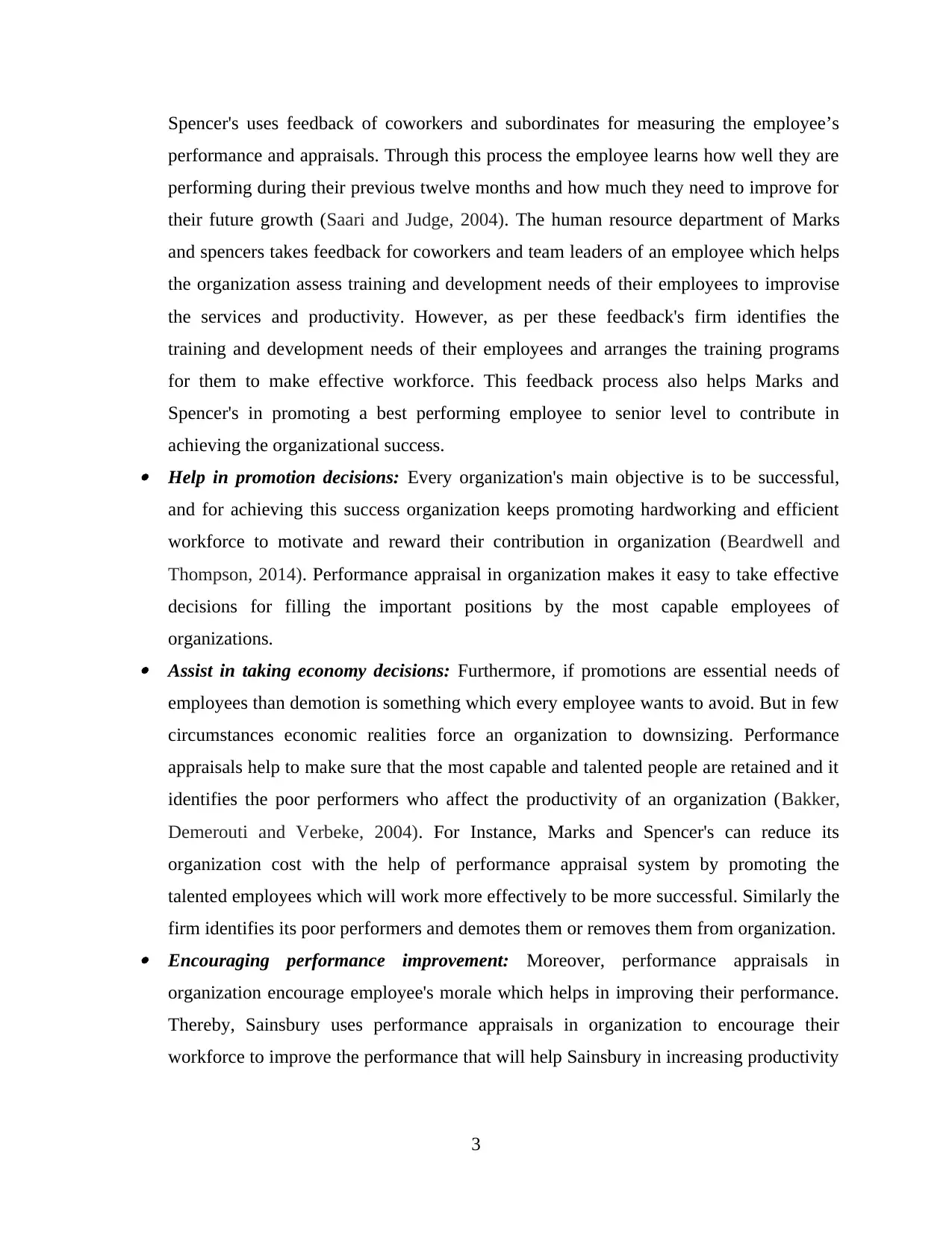
Spencer's uses feedback of coworkers and subordinates for measuring the employee’s
performance and appraisals. Through this process the employee learns how well they are
performing during their previous twelve months and how much they need to improve for
their future growth (Saari and Judge, 2004). The human resource department of Marks
and spencers takes feedback for coworkers and team leaders of an employee which helps
the organization assess training and development needs of their employees to improvise
the services and productivity. However, as per these feedback's firm identifies the
training and development needs of their employees and arranges the training programs
for them to make effective workforce. This feedback process also helps Marks and
Spencer's in promoting a best performing employee to senior level to contribute in
achieving the organizational success. Help in promotion decisions: Every organization's main objective is to be successful,
and for achieving this success organization keeps promoting hardworking and efficient
workforce to motivate and reward their contribution in organization (Beardwell and
Thompson, 2014). Performance appraisal in organization makes it easy to take effective
decisions for filling the important positions by the most capable employees of
organizations. Assist in taking economy decisions: Furthermore, if promotions are essential needs of
employees than demotion is something which every employee wants to avoid. But in few
circumstances economic realities force an organization to downsizing. Performance
appraisals help to make sure that the most capable and talented people are retained and it
identifies the poor performers who affect the productivity of an organization (Bakker,
Demerouti and Verbeke, 2004). For Instance, Marks and Spencer's can reduce its
organization cost with the help of performance appraisal system by promoting the
talented employees which will work more effectively to be more successful. Similarly the
firm identifies its poor performers and demotes them or removes them from organization. Encouraging performance improvement: Moreover, performance appraisals in
organization encourage employee's morale which helps in improving their performance.
Thereby, Sainsbury uses performance appraisals in organization to encourage their
workforce to improve the performance that will help Sainsbury in increasing productivity
3
performance and appraisals. Through this process the employee learns how well they are
performing during their previous twelve months and how much they need to improve for
their future growth (Saari and Judge, 2004). The human resource department of Marks
and spencers takes feedback for coworkers and team leaders of an employee which helps
the organization assess training and development needs of their employees to improvise
the services and productivity. However, as per these feedback's firm identifies the
training and development needs of their employees and arranges the training programs
for them to make effective workforce. This feedback process also helps Marks and
Spencer's in promoting a best performing employee to senior level to contribute in
achieving the organizational success. Help in promotion decisions: Every organization's main objective is to be successful,
and for achieving this success organization keeps promoting hardworking and efficient
workforce to motivate and reward their contribution in organization (Beardwell and
Thompson, 2014). Performance appraisal in organization makes it easy to take effective
decisions for filling the important positions by the most capable employees of
organizations. Assist in taking economy decisions: Furthermore, if promotions are essential needs of
employees than demotion is something which every employee wants to avoid. But in few
circumstances economic realities force an organization to downsizing. Performance
appraisals help to make sure that the most capable and talented people are retained and it
identifies the poor performers who affect the productivity of an organization (Bakker,
Demerouti and Verbeke, 2004). For Instance, Marks and Spencer's can reduce its
organization cost with the help of performance appraisal system by promoting the
talented employees which will work more effectively to be more successful. Similarly the
firm identifies its poor performers and demotes them or removes them from organization. Encouraging performance improvement: Moreover, performance appraisals in
organization encourage employee's morale which helps in improving their performance.
Thereby, Sainsbury uses performance appraisals in organization to encourage their
workforce to improve the performance that will help Sainsbury in increasing productivity
3
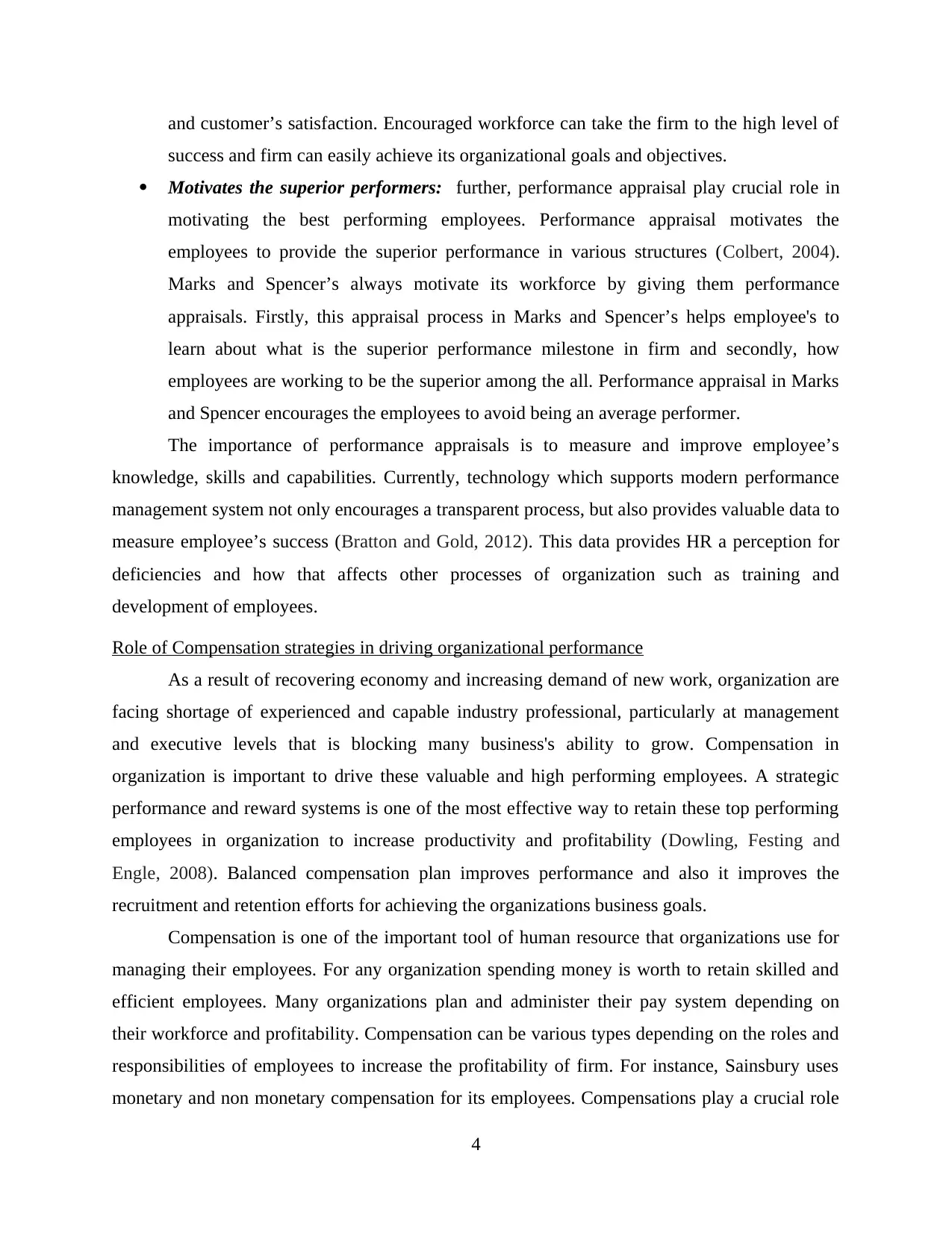
and customer’s satisfaction. Encouraged workforce can take the firm to the high level of
success and firm can easily achieve its organizational goals and objectives.
Motivates the superior performers: further, performance appraisal play crucial role in
motivating the best performing employees. Performance appraisal motivates the
employees to provide the superior performance in various structures (Colbert, 2004).
Marks and Spencer’s always motivate its workforce by giving them performance
appraisals. Firstly, this appraisal process in Marks and Spencer’s helps employee's to
learn about what is the superior performance milestone in firm and secondly, how
employees are working to be the superior among the all. Performance appraisal in Marks
and Spencer encourages the employees to avoid being an average performer.
The importance of performance appraisals is to measure and improve employee’s
knowledge, skills and capabilities. Currently, technology which supports modern performance
management system not only encourages a transparent process, but also provides valuable data to
measure employee’s success (Bratton and Gold, 2012). This data provides HR a perception for
deficiencies and how that affects other processes of organization such as training and
development of employees.
Role of Compensation strategies in driving organizational performance
As a result of recovering economy and increasing demand of new work, organization are
facing shortage of experienced and capable industry professional, particularly at management
and executive levels that is blocking many business's ability to grow. Compensation in
organization is important to drive these valuable and high performing employees. A strategic
performance and reward systems is one of the most effective way to retain these top performing
employees in organization to increase productivity and profitability (Dowling, Festing and
Engle, 2008). Balanced compensation plan improves performance and also it improves the
recruitment and retention efforts for achieving the organizations business goals.
Compensation is one of the important tool of human resource that organizations use for
managing their employees. For any organization spending money is worth to retain skilled and
efficient employees. Many organizations plan and administer their pay system depending on
their workforce and profitability. Compensation can be various types depending on the roles and
responsibilities of employees to increase the profitability of firm. For instance, Sainsbury uses
monetary and non monetary compensation for its employees. Compensations play a crucial role
4
success and firm can easily achieve its organizational goals and objectives.
Motivates the superior performers: further, performance appraisal play crucial role in
motivating the best performing employees. Performance appraisal motivates the
employees to provide the superior performance in various structures (Colbert, 2004).
Marks and Spencer’s always motivate its workforce by giving them performance
appraisals. Firstly, this appraisal process in Marks and Spencer’s helps employee's to
learn about what is the superior performance milestone in firm and secondly, how
employees are working to be the superior among the all. Performance appraisal in Marks
and Spencer encourages the employees to avoid being an average performer.
The importance of performance appraisals is to measure and improve employee’s
knowledge, skills and capabilities. Currently, technology which supports modern performance
management system not only encourages a transparent process, but also provides valuable data to
measure employee’s success (Bratton and Gold, 2012). This data provides HR a perception for
deficiencies and how that affects other processes of organization such as training and
development of employees.
Role of Compensation strategies in driving organizational performance
As a result of recovering economy and increasing demand of new work, organization are
facing shortage of experienced and capable industry professional, particularly at management
and executive levels that is blocking many business's ability to grow. Compensation in
organization is important to drive these valuable and high performing employees. A strategic
performance and reward systems is one of the most effective way to retain these top performing
employees in organization to increase productivity and profitability (Dowling, Festing and
Engle, 2008). Balanced compensation plan improves performance and also it improves the
recruitment and retention efforts for achieving the organizations business goals.
Compensation is one of the important tool of human resource that organizations use for
managing their employees. For any organization spending money is worth to retain skilled and
efficient employees. Many organizations plan and administer their pay system depending on
their workforce and profitability. Compensation can be various types depending on the roles and
responsibilities of employees to increase the profitability of firm. For instance, Sainsbury uses
monetary and non monetary compensation for its employees. Compensations play a crucial role
4
⊘ This is a preview!⊘
Do you want full access?
Subscribe today to unlock all pages.

Trusted by 1+ million students worldwide
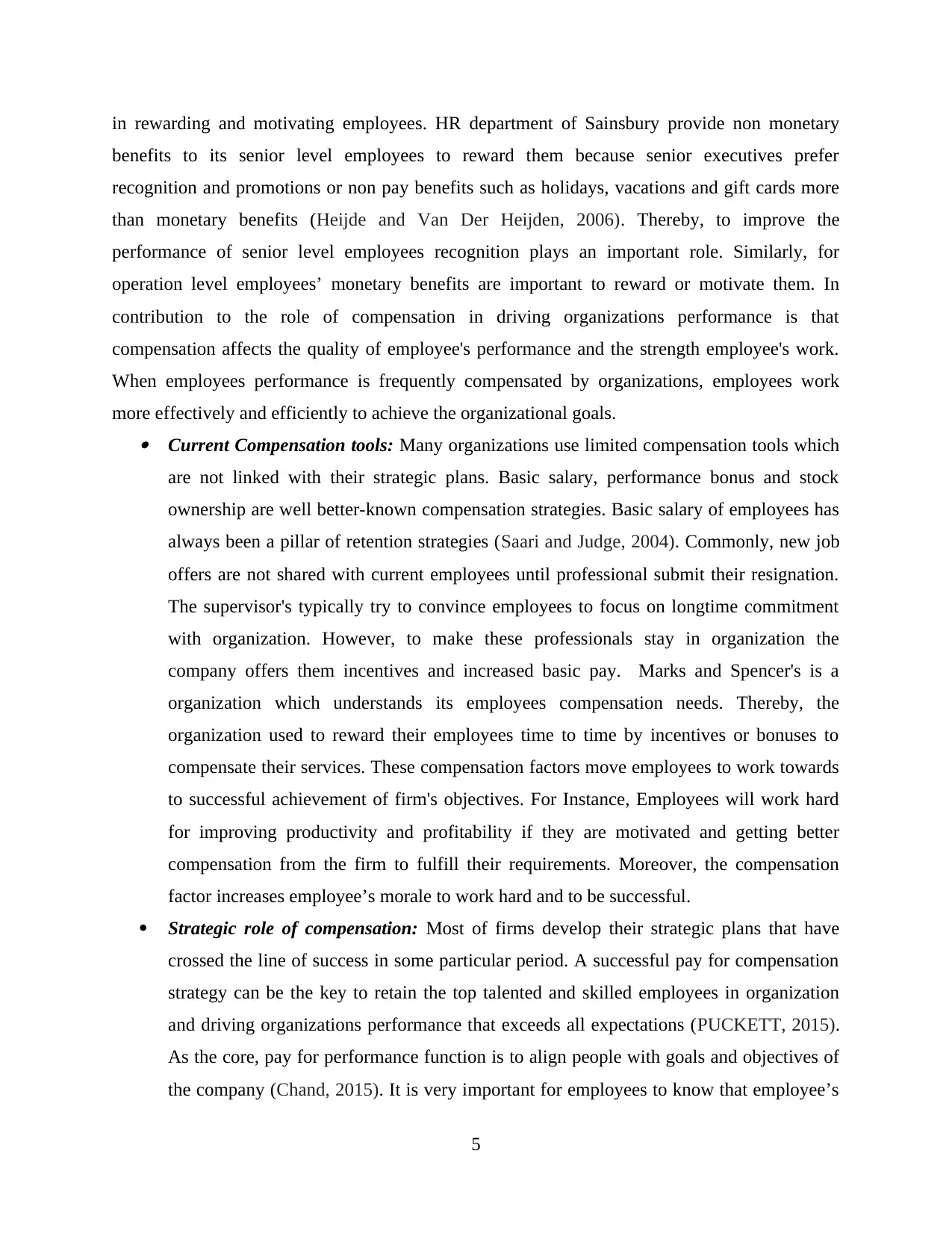
in rewarding and motivating employees. HR department of Sainsbury provide non monetary
benefits to its senior level employees to reward them because senior executives prefer
recognition and promotions or non pay benefits such as holidays, vacations and gift cards more
than monetary benefits (Heijde and Van Der Heijden, 2006). Thereby, to improve the
performance of senior level employees recognition plays an important role. Similarly, for
operation level employees’ monetary benefits are important to reward or motivate them. In
contribution to the role of compensation in driving organizations performance is that
compensation affects the quality of employee's performance and the strength employee's work.
When employees performance is frequently compensated by organizations, employees work
more effectively and efficiently to achieve the organizational goals. Current Compensation tools: Many organizations use limited compensation tools which
are not linked with their strategic plans. Basic salary, performance bonus and stock
ownership are well better-known compensation strategies. Basic salary of employees has
always been a pillar of retention strategies (Saari and Judge, 2004). Commonly, new job
offers are not shared with current employees until professional submit their resignation.
The supervisor's typically try to convince employees to focus on longtime commitment
with organization. However, to make these professionals stay in organization the
company offers them incentives and increased basic pay. Marks and Spencer's is a
organization which understands its employees compensation needs. Thereby, the
organization used to reward their employees time to time by incentives or bonuses to
compensate their services. These compensation factors move employees to work towards
to successful achievement of firm's objectives. For Instance, Employees will work hard
for improving productivity and profitability if they are motivated and getting better
compensation from the firm to fulfill their requirements. Moreover, the compensation
factor increases employee’s morale to work hard and to be successful.
Strategic role of compensation: Most of firms develop their strategic plans that have
crossed the line of success in some particular period. A successful pay for compensation
strategy can be the key to retain the top talented and skilled employees in organization
and driving organizations performance that exceeds all expectations (PUCKETT, 2015).
As the core, pay for performance function is to align people with goals and objectives of
the company (Chand, 2015). It is very important for employees to know that employee’s
5
benefits to its senior level employees to reward them because senior executives prefer
recognition and promotions or non pay benefits such as holidays, vacations and gift cards more
than monetary benefits (Heijde and Van Der Heijden, 2006). Thereby, to improve the
performance of senior level employees recognition plays an important role. Similarly, for
operation level employees’ monetary benefits are important to reward or motivate them. In
contribution to the role of compensation in driving organizations performance is that
compensation affects the quality of employee's performance and the strength employee's work.
When employees performance is frequently compensated by organizations, employees work
more effectively and efficiently to achieve the organizational goals. Current Compensation tools: Many organizations use limited compensation tools which
are not linked with their strategic plans. Basic salary, performance bonus and stock
ownership are well better-known compensation strategies. Basic salary of employees has
always been a pillar of retention strategies (Saari and Judge, 2004). Commonly, new job
offers are not shared with current employees until professional submit their resignation.
The supervisor's typically try to convince employees to focus on longtime commitment
with organization. However, to make these professionals stay in organization the
company offers them incentives and increased basic pay. Marks and Spencer's is a
organization which understands its employees compensation needs. Thereby, the
organization used to reward their employees time to time by incentives or bonuses to
compensate their services. These compensation factors move employees to work towards
to successful achievement of firm's objectives. For Instance, Employees will work hard
for improving productivity and profitability if they are motivated and getting better
compensation from the firm to fulfill their requirements. Moreover, the compensation
factor increases employee’s morale to work hard and to be successful.
Strategic role of compensation: Most of firms develop their strategic plans that have
crossed the line of success in some particular period. A successful pay for compensation
strategy can be the key to retain the top talented and skilled employees in organization
and driving organizations performance that exceeds all expectations (PUCKETT, 2015).
As the core, pay for performance function is to align people with goals and objectives of
the company (Chand, 2015). It is very important for employees to know that employee’s
5
Paraphrase This Document
Need a fresh take? Get an instant paraphrase of this document with our AI Paraphraser
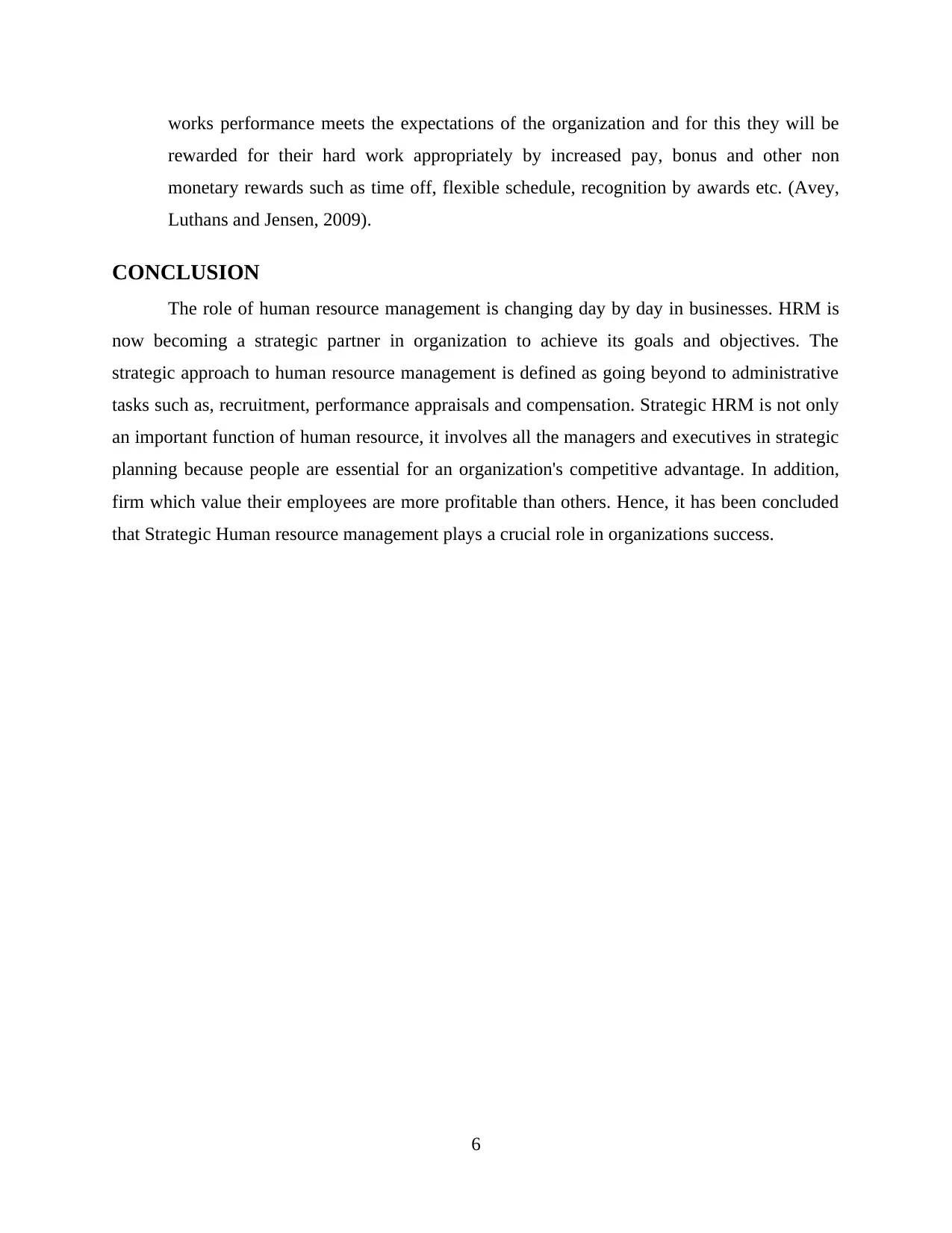
works performance meets the expectations of the organization and for this they will be
rewarded for their hard work appropriately by increased pay, bonus and other non
monetary rewards such as time off, flexible schedule, recognition by awards etc. (Avey,
Luthans and Jensen, 2009).
CONCLUSION
The role of human resource management is changing day by day in businesses. HRM is
now becoming a strategic partner in organization to achieve its goals and objectives. The
strategic approach to human resource management is defined as going beyond to administrative
tasks such as, recruitment, performance appraisals and compensation. Strategic HRM is not only
an important function of human resource, it involves all the managers and executives in strategic
planning because people are essential for an organization's competitive advantage. In addition,
firm which value their employees are more profitable than others. Hence, it has been concluded
that Strategic Human resource management plays a crucial role in organizations success.
6
rewarded for their hard work appropriately by increased pay, bonus and other non
monetary rewards such as time off, flexible schedule, recognition by awards etc. (Avey,
Luthans and Jensen, 2009).
CONCLUSION
The role of human resource management is changing day by day in businesses. HRM is
now becoming a strategic partner in organization to achieve its goals and objectives. The
strategic approach to human resource management is defined as going beyond to administrative
tasks such as, recruitment, performance appraisals and compensation. Strategic HRM is not only
an important function of human resource, it involves all the managers and executives in strategic
planning because people are essential for an organization's competitive advantage. In addition,
firm which value their employees are more profitable than others. Hence, it has been concluded
that Strategic Human resource management plays a crucial role in organizations success.
6
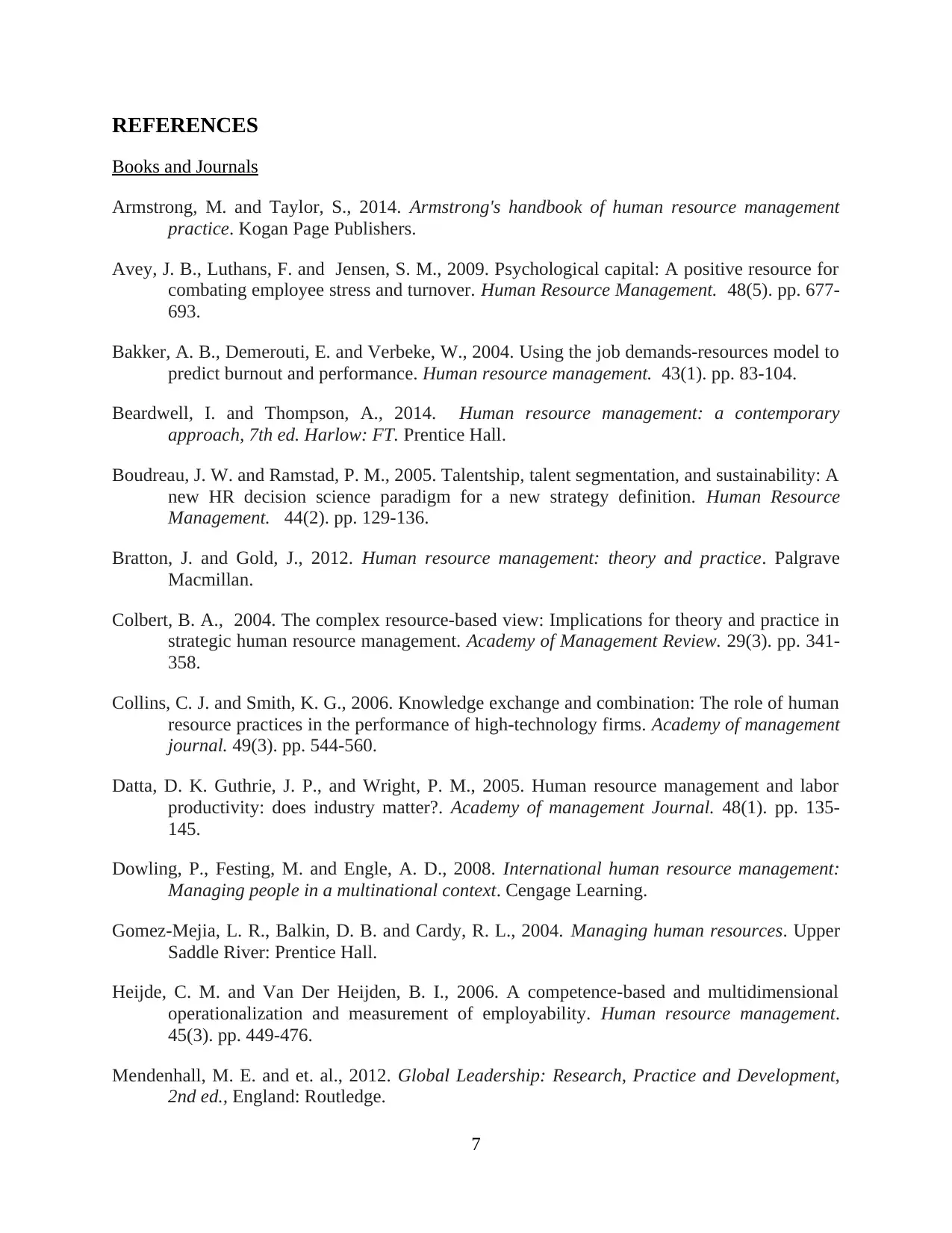
REFERENCES
Books and Journals
Armstrong, M. and Taylor, S., 2014. Armstrong's handbook of human resource management
practice. Kogan Page Publishers.
Avey, J. B., Luthans, F. and Jensen, S. M., 2009. Psychological capital: A positive resource for
combating employee stress and turnover. Human Resource Management. 48(5). pp. 677-
693.
Bakker, A. B., Demerouti, E. and Verbeke, W., 2004. Using the job demands‐resources model to
predict burnout and performance. Human resource management. 43(1). pp. 83-104.
Beardwell, I. and Thompson, A., 2014. Human resource management: a contemporary
approach, 7th ed. Harlow: FT. Prentice Hall.
Boudreau, J. W. and Ramstad, P. M., 2005. Talentship, talent segmentation, and sustainability: A
new HR decision science paradigm for a new strategy definition. Human Resource
Management. 44(2). pp. 129-136.
Bratton, J. and Gold, J., 2012. Human resource management: theory and practice. Palgrave
Macmillan.
Colbert, B. A., 2004. The complex resource-based view: Implications for theory and practice in
strategic human resource management. Academy of Management Review. 29(3). pp. 341-
358.
Collins, C. J. and Smith, K. G., 2006. Knowledge exchange and combination: The role of human
resource practices in the performance of high-technology firms. Academy of management
journal. 49(3). pp. 544-560.
Datta, D. K. Guthrie, J. P., and Wright, P. M., 2005. Human resource management and labor
productivity: does industry matter?. Academy of management Journal. 48(1). pp. 135-
145.
Dowling, P., Festing, M. and Engle, A. D., 2008. International human resource management:
Managing people in a multinational context. Cengage Learning.
Gomez-Mejia, L. R., Balkin, D. B. and Cardy, R. L., 2004. Managing human resources. Upper
Saddle River: Prentice Hall.
Heijde, C. M. and Van Der Heijden, B. I., 2006. A competence‐based and multidimensional
operationalization and measurement of employability. Human resource management.
45(3). pp. 449-476.
Mendenhall, M. E. and et. al., 2012. Global Leadership: Research, Practice and Development,
2nd ed., England: Routledge.
7
Books and Journals
Armstrong, M. and Taylor, S., 2014. Armstrong's handbook of human resource management
practice. Kogan Page Publishers.
Avey, J. B., Luthans, F. and Jensen, S. M., 2009. Psychological capital: A positive resource for
combating employee stress and turnover. Human Resource Management. 48(5). pp. 677-
693.
Bakker, A. B., Demerouti, E. and Verbeke, W., 2004. Using the job demands‐resources model to
predict burnout and performance. Human resource management. 43(1). pp. 83-104.
Beardwell, I. and Thompson, A., 2014. Human resource management: a contemporary
approach, 7th ed. Harlow: FT. Prentice Hall.
Boudreau, J. W. and Ramstad, P. M., 2005. Talentship, talent segmentation, and sustainability: A
new HR decision science paradigm for a new strategy definition. Human Resource
Management. 44(2). pp. 129-136.
Bratton, J. and Gold, J., 2012. Human resource management: theory and practice. Palgrave
Macmillan.
Colbert, B. A., 2004. The complex resource-based view: Implications for theory and practice in
strategic human resource management. Academy of Management Review. 29(3). pp. 341-
358.
Collins, C. J. and Smith, K. G., 2006. Knowledge exchange and combination: The role of human
resource practices in the performance of high-technology firms. Academy of management
journal. 49(3). pp. 544-560.
Datta, D. K. Guthrie, J. P., and Wright, P. M., 2005. Human resource management and labor
productivity: does industry matter?. Academy of management Journal. 48(1). pp. 135-
145.
Dowling, P., Festing, M. and Engle, A. D., 2008. International human resource management:
Managing people in a multinational context. Cengage Learning.
Gomez-Mejia, L. R., Balkin, D. B. and Cardy, R. L., 2004. Managing human resources. Upper
Saddle River: Prentice Hall.
Heijde, C. M. and Van Der Heijden, B. I., 2006. A competence‐based and multidimensional
operationalization and measurement of employability. Human resource management.
45(3). pp. 449-476.
Mendenhall, M. E. and et. al., 2012. Global Leadership: Research, Practice and Development,
2nd ed., England: Routledge.
7
⊘ This is a preview!⊘
Do you want full access?
Subscribe today to unlock all pages.

Trusted by 1+ million students worldwide
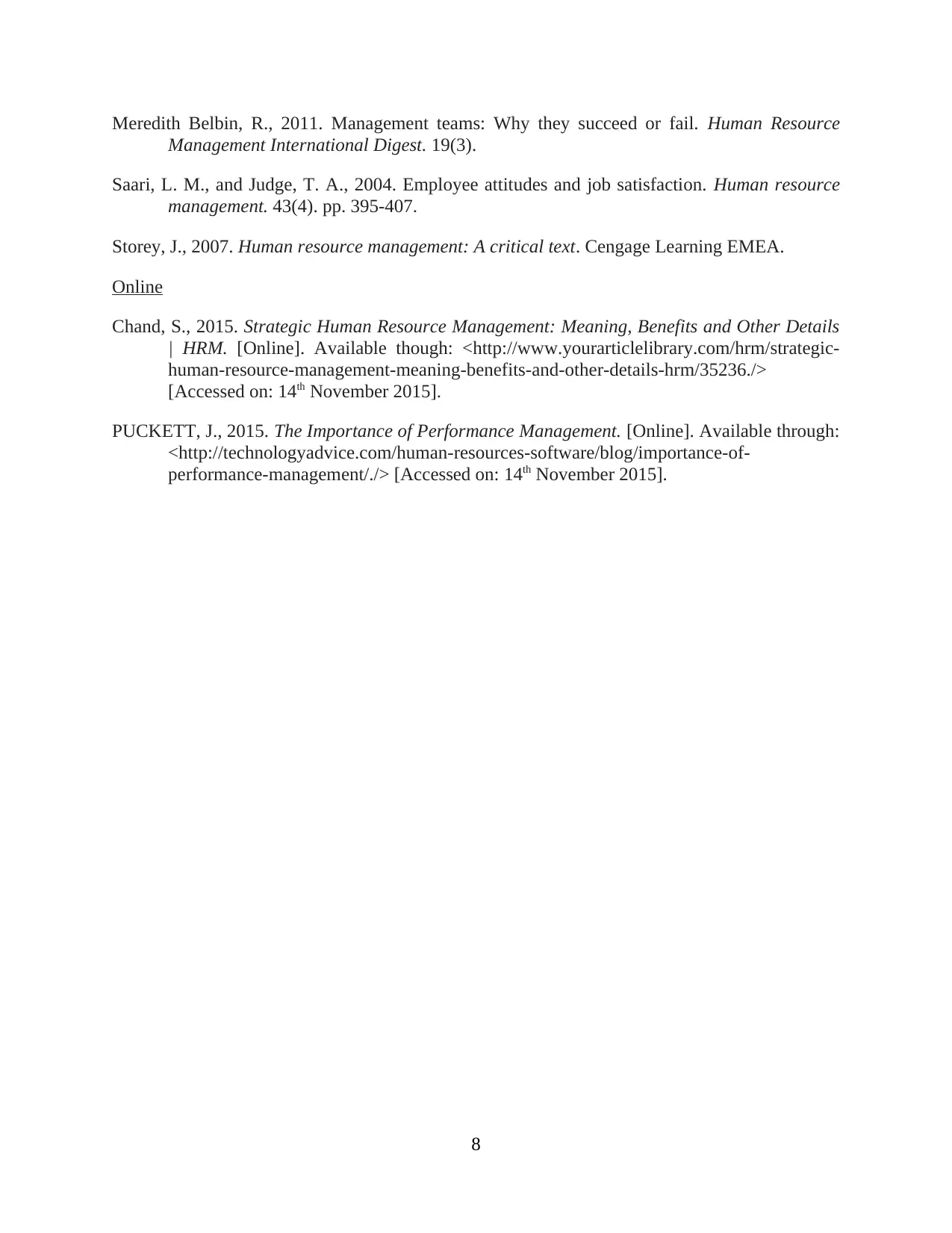
Meredith Belbin, R., 2011. Management teams: Why they succeed or fail. Human Resource
Management International Digest. 19(3).
Saari, L. M., and Judge, T. A., 2004. Employee attitudes and job satisfaction. Human resource
management. 43(4). pp. 395-407.
Storey, J., 2007. Human resource management: A critical text. Cengage Learning EMEA.
Online
Chand, S., 2015. Strategic Human Resource Management: Meaning, Benefits and Other Details
| HRM. [Online]. Available though: <http://www.yourarticlelibrary.com/hrm/strategic-
human-resource-management-meaning-benefits-and-other-details-hrm/35236./>
[Accessed on: 14th November 2015].
PUCKETT, J., 2015. The Importance of Performance Management. [Online]. Available through:
<http://technologyadvice.com/human-resources-software/blog/importance-of-
performance-management/./> [Accessed on: 14th November 2015].
8
Management International Digest. 19(3).
Saari, L. M., and Judge, T. A., 2004. Employee attitudes and job satisfaction. Human resource
management. 43(4). pp. 395-407.
Storey, J., 2007. Human resource management: A critical text. Cengage Learning EMEA.
Online
Chand, S., 2015. Strategic Human Resource Management: Meaning, Benefits and Other Details
| HRM. [Online]. Available though: <http://www.yourarticlelibrary.com/hrm/strategic-
human-resource-management-meaning-benefits-and-other-details-hrm/35236./>
[Accessed on: 14th November 2015].
PUCKETT, J., 2015. The Importance of Performance Management. [Online]. Available through:
<http://technologyadvice.com/human-resources-software/blog/importance-of-
performance-management/./> [Accessed on: 14th November 2015].
8
1 out of 10
Related Documents
Your All-in-One AI-Powered Toolkit for Academic Success.
+13062052269
info@desklib.com
Available 24*7 on WhatsApp / Email
![[object Object]](/_next/static/media/star-bottom.7253800d.svg)
Unlock your academic potential
Copyright © 2020–2025 A2Z Services. All Rights Reserved. Developed and managed by ZUCOL.





